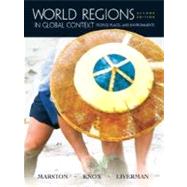
| A World of Regions | |
| The Power of Geography: A World of Regions:The Regional Approach | |
| The Interdependence of Geographic Scales | |
| Boundaries and Frontiers | |
| Regionalism and Sectionalism | |
| Places and Regions in an Interdependent World:Globalization | |
| Globalization and Environmental Change | |
| The Global Context: Some Important Patterns:Religion | |
| Language | |
| Population Distribution | |
| Urbanization | |
| Economic Development and Social Well-being | |
| The Foundations of World Regions | |
| The Changing World:The Earth System | |
| The World-System | |
| Geographic Expansion, Integration, and Change:The Growth of Early Empires | |
| The Geographic Foundations of the Modern World | |
| Organizing the Core:The Division of Labor | |
| Standardizing Time, Space, Measure, Value, and Money | |
| Forging National Identities and Constructing States | |
| Controlling and Commodifying Nature | |
| Developing Internal Infrastructures | |
| Organizing the Periphery:Imperialism and Colonialism: Imposing New Geographies on the World | |
| An International Division of Labor | |
| Political and Cultural Geographies | |
| Exploration and Exploitation | |
| Developing Internal Infrastructures | |
| Globalization and Economic Development:Deploying and Encountering Development | |
| Five Key Factors of Globalization | |
| Transnational Economic Integration | |
| Europe | |
| Environment and Society in Europe:Landforms and Landscapes | |
| Climate | |
| Environmental History | |
| Europe in the World-System:Trade and the Age of Discovery | |
| Industrialization and Imperialism | |
| Eastern Europe's Interlude of State Socialism | |
| The Peoples of Europe:The European Diaspora | |
| Migration Within Europe | |
| Recent Migration Streams | |
| European Cultural Traditions | |
| Culture and Ethnicity, Nations and States | |
| Contemporary Challenges in a Globalizing World:Growth, Deindustrialization, and Reinvestment | |
| The European Union | |
| The Reintegration of Eastern Europe | |
| Core Regions and Distinctive Landscapes:Europe's Golden Triangle | |
| The Southern Crescent | |
| Mediterranean Europe | |
| Alpine Europe | |
| Nordic Europe | |
| The Danubian Plains | |
| The Russian Federation, Central Asia, and the Transcaucasus | |
| Environment and Society:Climate | |
| Physiographic Regions | |
| Natural Landscapes | |
| Environmental History | |
| Russia, Central Asia, and the Transcaucasus in the World-System:Muscovy and the Russian Empire | |
| The Soviet Empire | |
| New Realities | |
| The Peoples of Russia, Central Asia, and the Transcaucasus:The Russian Diaspora and Migration Streams | |
| Nationalisms | |
| Contemporary Challenges in a Globalizing World:Problems of Economic and Social Transformation | |
| Gender and Inequality | |
| Core Regions and Distinctive Landscapes:The Central Region | |
| The Volga Region | |
| The Urals | |
| The Tundra | |
| Central Siberian Taiga | |
| The Steppes | |
| The Central Asian Deserts | |
| Middle East and North Africa | |
| Environment and Society in the Middle East and North Africa:Landforms and Landscapes | |
| Climate | |
| Environmental History | |
| The M | |
| Table of Contents provided by Publisher. All Rights Reserved. |
The New copy of this book will include any supplemental materials advertised. Please check the title of the book to determine if it should include any access cards, study guides, lab manuals, CDs, etc.
The Used, Rental and eBook copies of this book are not guaranteed to include any supplemental materials. Typically, only the book itself is included. This is true even if the title states it includes any access cards, study guides, lab manuals, CDs, etc.